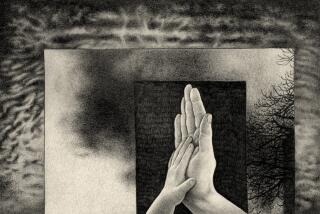Fighting fear with fear
- Share via
When people become intensely anxious, the body responds with an adrenaline rush that increases heart and respiration rates -- that sweaty, heart-thumping, gasping-for-air feeling. For the estimated 19 million Americans with anxiety disorders, however, this sensation occurs frequently, often without warning and can interfere with normal activities.
Treatment for anxiety disorders usually is designed to erode that response, either through medications or gentle, gradual exposure to the object or situation causing fear. Dr. Mark Barad of UCLA’s Neuropsychiatric Institute is among a group of doctors who are turning the traditional treatment paradigm on its head. Barad, an assistant professor of psychiatry and biobehavioral sciences, says that people can learn more quickly to overcome these disorders by intense, frequent exposure to a fear during behavioral therapy. He describes his research, which has been conducted primarily in animals but is moving into human studies.
*
Question: How has anxiety been treated traditionally?
Answer: The older kinds of treatments were psychotherapy, where people talked about their fears.... In the 1950s and ‘60s, a man named Joseph Wolpe [a Temple University psychiatry professor who died in 1997] devised a technique called gradual desensitization, which is exposing the person, little by little, to the fear so that they get over it. More recently, people have used medications, particularly antidepressants. But nobody really knows how they work.
*
Q: How is your approach different?
A: We’re looking at ways to improve behavioral therapy. We take two approaches. One is to improve the ways in which people get exposed to their fears. And the other is to understand the molecular mechanisms for how people develop fear. This could then lead to drugs that make behavioral therapies work better.
*
Q: What are you doing to make behavioral therapies more successful?
A: One of the big problems with behavioral therapy is it takes a very long time. Gradual desensitization is a bit-by-bit approach in which you expose the patients gradually to the fear. We actually started out trying to figure out if we can make the process go faster.
*
Q: How did you go about that?
A: What we did was to test to see if mice got over their fears faster if they were exposed to their fears gradually or all at once.... This is called massed versus spaced. We gave mice 20 exposures to something they were afraid of. These were things we made them afraid of. We gave them the exposures with different spacing (ranging from six seconds to 600 seconds). We found, much to our surprise, that the less space there was between exposures, the faster the animals got over their fear and the more they got over their fear. This is the opposite from what we expected.
*
Q: Why do you think frequent exposure worked better?
A: What we believe is that the brain does not allow you to learn to forget your fear unless it’s absolutely sure you’re safe. You have to overcome that with a critical mass of exposure, then the learning starts. But the proof of that, in terms of head-to-head studies, hasn’t been done yet. I just received funding to do that kind of study [in humans], and we’ll be starting that this summer.
*
Q: How could medications help facilitate this treatment?
A: We have one published study and have another that looks ... at a substance called yohimbine. Yohimbine is a natural herbal medication derived from a tree bark. It was [and still is] used for sexual disorders in men. It’s a stimulant. By itself, yohimbine has been shown to increase anxiety in people who are prone to panic disorder. But we find that if we combine it with this model of therapy [in mice] that it really facilitates extinction [the erasure of fear]. We get extinction faster with massed exposures and yohimbine. Most interesting of all, even when we do spaced exposures -- which usually doesn’t work -- we now get extinction when we add yohimbine. It allows the animal to learn to overcome the fear.
*
Q: But people with anxiety shouldn’t take yohimbine on their own, should they?
A: It’s probably actually bad for anxiety. It needs to be taken in conjunction with psychotherapy.
*
Q: So, overall, you’re suggesting that the best way to overcome anxiety is to face -- head-on -- the thing that’s making you anxious?
A: I think that is the emerging message. In fact, there is a hypothesis that the more afraid you are during extinction learning, the more you’ll extinguish. But it’s really important to experience the anxiety under circumstances in which you are safe.
*
(BEGIN TEXT OF INFOBOX)
Anxiety disorders
Anxiety disorders are the most common of emotional disorders, affecting about one in nine people.
Symptoms include overwhelming feelings of panic and fear; uncontrollable obsessive thoughts; intrusive memories or recurring nightmares; physical symptoms, including nausea, sweating and muscle tension.
Various anxiety disorders include panic disorder, phobias, obsessive-compulsive disorder, post-traumatic stress disorder and generalized anxiety disorder.
Most anxiety disorders respond well to treatments, such as medication and psychotherapy.
Source: American Psychiatric Assn.






